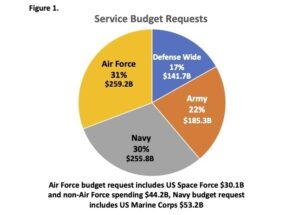Biden’s federal budget submission for fiscal year 2024 is enormous. The White House’s spending request of $6.9 trillion includes the largest President’s Budget Request for Defense (PBD) ever at $886 billion. The total consists of atomic energy defense activities and a variety of other costs including upgraded weapons systems and a personnel pay raise. This proposal is a $26 billion, or 3.2%, increase over the enacted FY2023 amount of $816 billion for Department of Defense (DOD) expenses only. A Pentagon briefing to the press on March 13 explained that the request supports the 2022 National Defense Strategy.
Defense Budget Provides Big Pay Raise
The biggest single winner in the internal Pentagon competition for funding was the personnel account, which saw a rise in base pay for military and civilians of 5.2% over the 2023 budget. The Defense Department comptroller explained the increase was the largest “in over 20 years for our military and over 40 years for our civilians.” Although the raise will probably not be met with significant pushback on Capitol Hill, Pentagon officials will nevertheless make a case for the larger paycheck. “Under Secretary of Defense for Personnel Gil Cisneros Jr. will appear before the Senate Armed Services Committee on Wednesday as part of a panel of manpower and medical experts. He made a similar appearance before the House Armed Services Committee earlier this month,” Leo Shane III reported in the Air Force Times. The armed services’ struggle with recruiting and keeping qualified people will be an essential talking point in defense of the increase in compensation.
Investments Lead Spending Priorities
Significant investments into weapon systems involve research and development, as well as procurement. Those investments include nuclear deterrence systems, missile defeat and defense systems, aircraft, shipbuilding, space systems, ground systems (light tactical vehicles, tanks, etc.), and munitions. The three largest budget items are 83 F-35 fifth-generation stealth fighters ($13.6 billion), one Columbia-class ballistic missile submarine, and two Virginia-class attack submarines. These three weapon systems account for $30.6 billion, or roughly 10% of the entire investment budget.

Based on the Department of Defense report
Other key investments in overall warfighting capability include hypersonic missiles and long-range subsonic missiles. The Defense Department intends to deliver “initial all-domain” hypersonic missile capability in the next five years. In addition, it expects to buy 24 new hypersonic missiles in FY2024 for prototype testing and to field a second complete ground-based hypersonic missile battery by FY2025. By contrast, Russia is already using hypersonic weapons, both air-launched and surface-launched, within Ukraine.
Nuclear Deterrence and Indo-Pacific Get Defense Budget Focus
The PBD requests $37.7 billion to support US nuclear modernization by ramping up production of the B-21 Raider strategic stealth bomber. The budget request also funds the Sentinel/Ground Based Strategic Deterrent (replacement for the Minuteman III Intercontinental Ground-based Ballistic Missile) and the command, control, and communications capability to manage US nuclear forces. As part of what the DOD refers to as “Integrated Deterrence,” the budget has $29.8 billion for a wide range of missile defense programs. An investment of $1.5 billion is included for the defending base infrastructure and operational capabilities in Guam to defeat the missile threat from China.
To meet the menace China represents in the Indo-Pacific, the Pentagon requested $9.1 billion to fortify island basing, establish new missile warning and tracking systems, and fund “multinational information sharing, training, and experimentation.” In the category of putting money where the DOD’s mouth is, preparing to engage the People’s Republic of China (PRC) is becoming more urgent. The PRC has significantly increased its defense spending, and the US cannot fall behind in deterring Beijing or, if necessary, defeating the People’s Liberation Army.
The Biden PBD is balanced between modernization, providing for near-term procurement requirements, and sustaining legacy systems. There is a lot of taxpayers’ money tied to this budget request. And the topline could easily climb because there is no supplemental funding for Ukraine. With the Biden administration’s support for the “as long as it takes” Kyiv assistance non-strategy, the defense budget sent to Congress could be just the beginning.
The views expressed are those of the author and not of any other affiliation.




